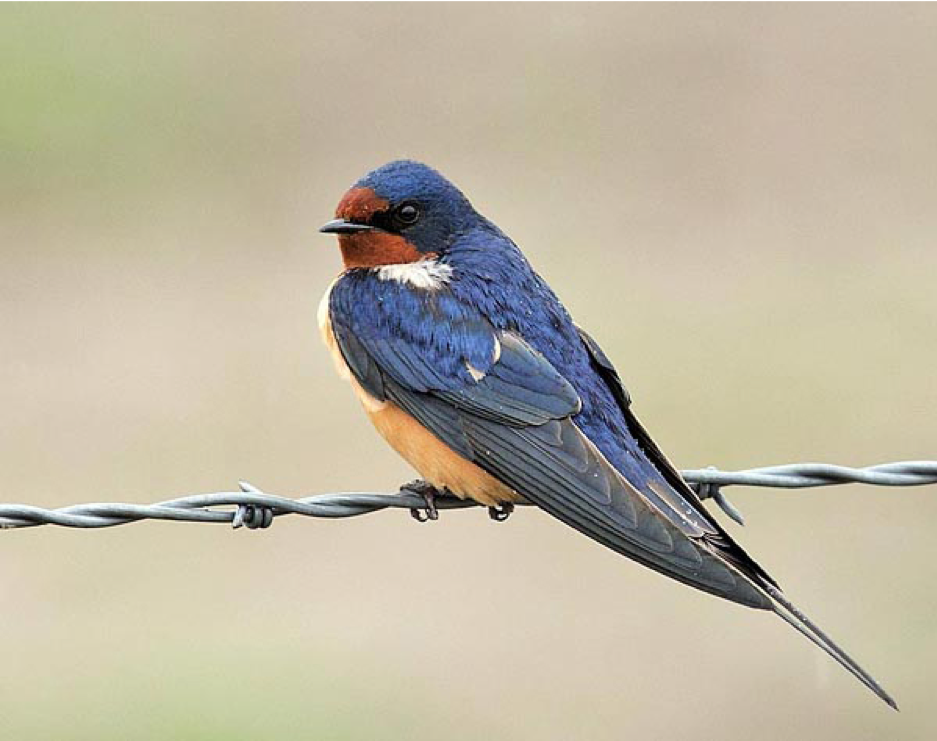
Barn Swallows
(Hirundo rustica)
All swallows are graceful fliers, but Barn Swallows are incredibly maneuverable due to a long, forked tail that allows for tight turns. They have iridescent blue/black upperparts and a chestnut forehead patch. Males are rufous below, with long tail streamers; females are a lighter rufous below with shorter tail streamers than males. Their breeding call is a cheerful warble that ends in a mechanical rasp sound. The alarm is a severe “chur-ee.” Barn Swallows tend to forage at lower altitudes than other North American swallows, feeding on single, large insects rather than insect swarms.
Range
The Barn Swallow is widely distributed, breeding in North America, Europe, and Asia. Those that breed in North America winter in Central and South America.
Visit the eBird Status and Trends Project website: https://ebird.org/science/status-and-trends.
Natural History
Originally nesting in caves, Barn Swallows were also nesting in structures built by Native Americans by the early 1800s. Their range greatly expanded after European settlement, and today Barn Swallows are almost exclusively found nesting in/on a great variety of man-made structures, including barns, sheds, outbuildings, garages, bridges, culverts, and docks. They are considered “loosely colonial,” but they do nest singly. They construct a cup-shaped nest of mud and vegetation often attached to a vertical surface, but also use horizontal surfaces of all types, such as light fixtures, or even nails or wires. They tend to avoid large platforms, preferring smaller supports that allow for open space around the nest. Nests are generally placed such that there is very little space above the top of the nest. They are attracted to, and will readily re-use nests remaining from previous years. Clutch size is 3–6 eggs, the incubation period is approximately 13–15 days, and young fledge approximately 20 days after hatching. Both members of a pair incubate and feed young. Barn Swallows have up to two broods per season.
Conservation Status
Although Barn Swallows originally benefitted from human-made landscape changes, the tide has turned and they are presently declining, alarmingly in some regions. Factors contributing to the decline are the decline of agriculture, regrowth of forests, suburbanization, urbanization, and the common practice of closing up barns. There are additional factors, beyond habitat loss, that may be contributing to population declines in several species of swallows, including Barn Swallows....
Barn Swallow populations declined by over 1% per year from 1966 to 2014, resulting in a cumulative decline of 46%, according to the North American Breeding Bird Survey. According to USGS Breeding Bird Survey data Barn Swallows have declined in Massachusetts by about 40% since 1985 and by about 29% since 2000. Similar trends are occurring in other Northeast states. Barn Swallows were designated as Threatened in Canada in May 2011. They are listed as Threatened in Ontario and Endangered in Nova Scotia. This species has experienced very large declines that began somewhat inexplicably in the mid- to late 1980s in Canada.
References
Brown, C. R., and M. B. Brown. 1999. Barn Swallow (Hirundo rustica). In The Birds of North America, No. 452 (A. Poole and F. Gill, eds.). The Birds of North America Online, Ithaca, New York.
COSEWIC. 2011. COSEWIC assessment and status report on the Barn Swallow Hirundo rustica in Canada. Committee on the Status of Endangered Wildlife in Canada. Ottawa ix +37 pp.
Macoun, J. and J. M. Macoun. 1909. Catalogue of Canadian birds. Ottawa: Govt. Printing Bureau.
Snapp, B. D. 1976. Colonial breeding in the Barn Swallow (Hirundo rustica) and its adaptive significance. Condor no. 78:471-480.
USGS Patuxent Wildlife Research Center. 2014. North American Breeding Bird Survey 1966–2014 Analysis.

